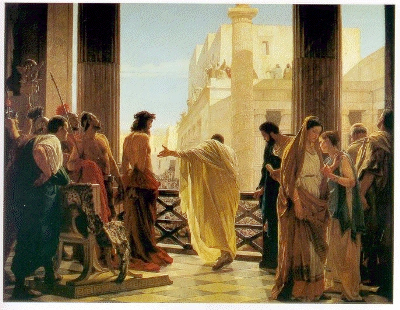Crucifixion Friday – Barabbas and Jesus
 One of the more controversial aspects of traditional Passion plays is the scene wherein Pontius Pilate offers to release one prisoner to the Jews, as part of what the Gospels indicate is a Passover custom in Roman-occupied Judea.
One of the more controversial aspects of traditional Passion plays is the scene wherein Pontius Pilate offers to release one prisoner to the Jews, as part of what the Gospels indicate is a Passover custom in Roman-occupied Judea.
The crowd gathered below chooses the criminal Barabbas, and insist that Jesus be crucified. The scene is often decried as anti-Semitic for its negative portrayal of the Jews as a violent, criminal mob, politically motivated and spiritually blind. Indeed it has often been used to stir up hatred against Jews.
But, a deeper meaning available in this scene is entirely missed by most. It begins with an understanding of the symbolism in the name Barabbas, which is Aramaic for “Son of the Father.” In the context of Christian theology, therefore, those gathered before Pilate chose the man who was named “Son of the Father” rather than the man who was the Son of the Father.
They chose outward appearance over inner reality. Continue reading

 Typically, Reform Unitarianism avoids the use of the cross. One reason is that the cross did not become an important symbol in Christianity until well into the 4th Century, after conflationist corruptions had begun to undermine Christian theology. The cross simply does not represent original Christianity.
Typically, Reform Unitarianism avoids the use of the cross. One reason is that the cross did not become an important symbol in Christianity until well into the 4th Century, after conflationist corruptions had begun to undermine Christian theology. The cross simply does not represent original Christianity.